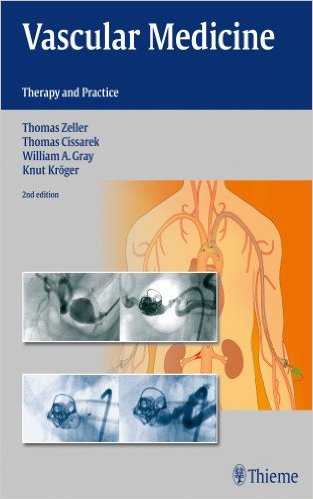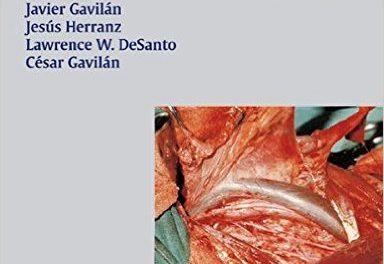Editors: Thomas Zeller, MD; Thomas Cissarek, MD; William A. Gray, MD; Knut Kroger, MD.
Associate Editor: Jerry Wojciuk, MD
Publisher: Thieme – 520 pages, with 948 illustrations
Book Review by: Nano Khilnani
This is a large-size text of more than 500 pages and nearly 950 illustrations on the various diseases of blood vessels in the human body. It is already the second (2014) edition, with the first one published just four years ago in 2010, because the advances in this have been ‘tremendous,’ particularly in endovascular therapy, as the editors describe them.
Seventy-two people, all from Germany except four from Switzerland, two each from Italy and the United States, and one each from Austria, Indonesia and New Zealand, wrote the 28 chapters of this book that are organized around five sections (see below).
The authors are specialists in various fields including: anesthesiology, angiology, cardiology, cardiovascular surgery, electrophysiology, endovcascular surgery, general surgery, internal medicine, kidney transplantation, lymphology, neuroradiology, nuclear medicine, phlebology, pulmonology, radiology, rheumatology, thoracic surgery, and vascular surgery.
- Diseases of the Arteries: 4 chapters
- Diseases of the Veins: 7 chapters
- Inflammatory Vascular Diseases: 13 chapters
- Congenital Vascular Diseases: 3 chapters
- Diseases of the Lymphatic System: 1 chapter
Among the improvements in this second edition are the following:
- Addition of an introductory anatomy section to each of the major chapters
- Addition of a detailed duplex ultrasonography section to each vascular section
- Substantial expansion of the content of the book with the addition of sections and chapters that did not find their way into the first edition for various reasons, with the main ones being:
- Diseases of the Lymphatic System
- Treatment of Acute Stroke
- Renal Sympathetic Denervation
- Surgical Treatment of Renal Artery Stenosis
The materials in the chapters are quite well organized and presented. Let us take a look at the 71-page-long chapter 1, Supra-Aortic Vessels, to get a broad view of what you will find in it.
The first topic of discussion in this chapter is: Extracranial stenoses and occlusive processes, in which the Anatomy of the extracranial arteries is discussed, followed by the topic Clinical picture (carotid artery, vertebral arterty).
These are followed by Clinical findings and Differential diagnoses, and Diagnosis. Within the third (Diagnosis) section, you will find detailed discussions under Doppler/duplex ultrasonography, including:
- Examination technique
- Examination of the carotid system
- Examination of the subclavian/vertebral artery system
- Differential diagnosis
- Specific findings on:
- a) common carotid artery,
- b) internal carotid artery,
- c) external carotid artery,
- d) subclavian artery, and
- e) vertebral artery
The next topic of discussion is Treatment. Within this section you will find various treatment options. The authors write: “Medical treatment is indicated in both internal carotid artery stenosis and vertebral artery stenosis, in order to limit atherosclerotic progression and reduce the risk of a neurologic event. This treatment recommendation is independent of the decision on whether to offer interventional or surgical revascularization therapy.”
The authors suggest two types of treatment: conservative treatment and endovascular treatment. The first type of treatment involves drug therapy including:
- Inhibition of platelets using acetysalycylic acid (ASA), dipyridamole plus acetysalycylic acid, or clopidogrel
- In addition, treatment with statins is advised due to their anti-inflammatory and thus plaque-stabilizing effect in other vascular territories
- Medical treatment alone is recommended in patients with stenosis of the internal carotid artery who either have a low risk of stroke (symptomatic stenosis of less than 50 percent or asymptomatic stenosis of less than 60 percent) or who have a high perioperative or peri-interventional risk due to comorbid conditions, or who have limited life expectancy
The other type, which is endovascular treatment (stent implantation) is recommended in cases where drug therapy is unlikely to reduce stenosis in carotid and vertebral arteries. In the section on Endovascular treatment, you will find helpful information on the following topics:
- Patient preparation
- Per-interventional therapy
In the section on Technique of carotid arterty stenting you will discover the following detailed subtopics:
- Engaging the common carotid artery
- Exploring the common carotid artery in difficult anatomy
- Visualizing the vessels
- Vascular kinking
- Placement of the guiding catheter
- Placement of the long sheath
- Carotid access in occluded external carotid artery or common carotid stenosis
- Predilation
- Protection against emboli
- Distal occlusion balloons
- Filter systems
- Proximal occlusion systems
- Stent implantation
- Postdilation
The next section is on the Technique of vertebral artery stenting with helpful instructions and steps. In summary, this is a very useful book on vascular medicine and surgery.
Editors:
Thomas Zeller, MD is Professor and Head of the Department of Angiology, Clinical Cardiology, and Angiology II at the University Heart Center at Freiburg-Bad Kroningen in Bad Kroningen, Germany.
Thomas Cissarek, MD works in the Department of Angiology, Phlebology, and Vascular Surgery at Gefaessfrankenheiten Rhein-Ruhr in Essen, Germany.
William A. Gray, MD is Director of Endovascular Services and Associate Professor of Medicine in the Center for Interventional Vasacular Therapy at Columbia University Medical Center – Presbyterian Hospital in New York, New York.
Knut Kroger, MD is Professor and Head of the Department of Angiology at HELIOS Hospital Krefeld in Krefeld, Germany.
Associate Editor:
Jerry Wojciuk, MD, LRCP Edin, LRCS Edin, LRCPS Glasg, MRCP (UK) works at the Lancashire Cardiac Centre at Blackpool, Lancashire, in the United Kingdom.







